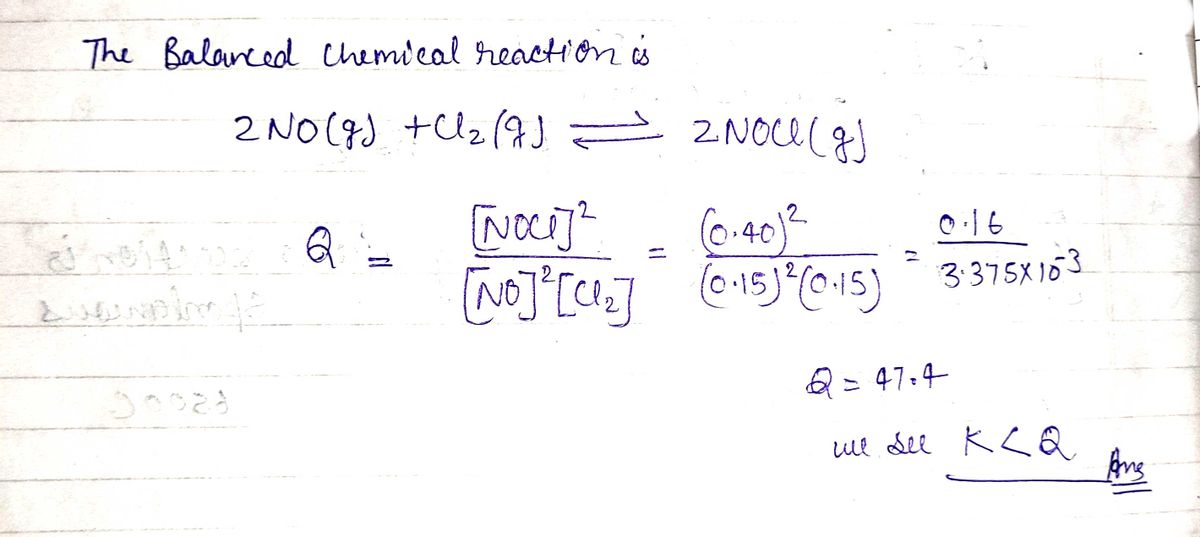For the following reaction, Kc = 15 at 700 K. 2 NO(g) + Cl2(g) ⇄ 2 NOCl(g) If we have [NO] = 0.15 M, [Cl2] = 0.15 M, [NOCl] = 0.40 M at 700 K, what will happen? Group of answer choices The equilibrium will not shift. The equilibrium will shift to the left until all the NOCl is used up. The equilibrium will shift to the right until all the reactants are used up. The equilibrium will shift to the left, but will use up only part of the NOCl. The equilibrium will shift to the right, but will use up only part of the NO and Cl2.
For the following reaction, Kc = 15 at 700 K. 2 NO(g) + Cl2(g) ⇄ 2 NOCl(g) If we have [NO] = 0.15 M, [Cl2] = 0.15 M, [NOCl] = 0.40 M at 700 K, what will happen? Group of answer choices The equilibrium will not shift. The equilibrium will shift to the left until all the NOCl is used up. The equilibrium will shift to the right until all the reactants are used up. The equilibrium will shift to the left, but will use up only part of the NOCl. The equilibrium will shift to the right, but will use up only part of the NO and Cl2.
Chemistry & Chemical Reactivity
9th Edition
ISBN:9781133949640
Author:John C. Kotz, Paul M. Treichel, John Townsend, David Treichel
Publisher:John C. Kotz, Paul M. Treichel, John Townsend, David Treichel
Chapter15: Principles Of Chemical Reactivity: Equilibria
Section15.6: Disturbing A Chemical Equilibrium
Problem 3RC
Related questions
Question
For the following reaction, Kc = 15 at 700 K.
2 NO(g) + Cl2(g) ⇄ 2 NOCl(g)
If we have [NO] = 0.15 M, [Cl2] = 0.15 M, [NOCl] = 0.40 M at 700 K, what will happen?
Group of answer choices
The equilibrium will not shift.
The equilibrium will shift to the left until all the NOCl is used up.
The equilibrium will shift to the right until all the reactants are used up.
The equilibrium will shift to the left, but will use up only part of the NOCl.
The equilibrium will shift to the right, but will use up only part of the NO and Cl2.
Expert Solution
Step 1
We found that When Q >K that means
product > reactant. So, the reaction is reactant favored.
So, the reaction is reactant favored that means reaction must shift to the reactants to be in equilibrium or shift to the left side.
Hence the 2nd option is correct that is, The equilibrium will shift to the left until all the NOCl is used up.
Trending now
This is a popular solution!
Step by step
Solved in 2 steps with 1 images

Knowledge Booster
Learn more about
Need a deep-dive on the concept behind this application? Look no further. Learn more about this topic, chemistry and related others by exploring similar questions and additional content below.Recommended textbooks for you

Chemistry & Chemical Reactivity
Chemistry
ISBN:
9781133949640
Author:
John C. Kotz, Paul M. Treichel, John Townsend, David Treichel
Publisher:
Cengage Learning

Chemistry: The Molecular Science
Chemistry
ISBN:
9781285199047
Author:
John W. Moore, Conrad L. Stanitski
Publisher:
Cengage Learning

Chemistry
Chemistry
ISBN:
9781305957404
Author:
Steven S. Zumdahl, Susan A. Zumdahl, Donald J. DeCoste
Publisher:
Cengage Learning

Chemistry & Chemical Reactivity
Chemistry
ISBN:
9781133949640
Author:
John C. Kotz, Paul M. Treichel, John Townsend, David Treichel
Publisher:
Cengage Learning

Chemistry: The Molecular Science
Chemistry
ISBN:
9781285199047
Author:
John W. Moore, Conrad L. Stanitski
Publisher:
Cengage Learning

Chemistry
Chemistry
ISBN:
9781305957404
Author:
Steven S. Zumdahl, Susan A. Zumdahl, Donald J. DeCoste
Publisher:
Cengage Learning

Chemistry: An Atoms First Approach
Chemistry
ISBN:
9781305079243
Author:
Steven S. Zumdahl, Susan A. Zumdahl
Publisher:
Cengage Learning


General Chemistry - Standalone book (MindTap Cour…
Chemistry
ISBN:
9781305580343
Author:
Steven D. Gammon, Ebbing, Darrell Ebbing, Steven D., Darrell; Gammon, Darrell Ebbing; Steven D. Gammon, Darrell D.; Gammon, Ebbing; Steven D. Gammon; Darrell
Publisher:
Cengage Learning